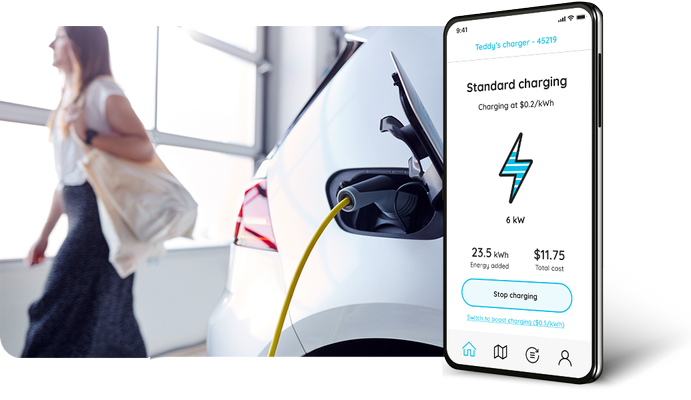Effie Vraka, Managing Director for UK and Europe at Wevo Energy, explains how property managers can electrify parking spaces without worrying about constrained electrical capacity.
Electrifying parking spaces in high-density buildings – like apartments and offices – is one of the biggest challenges at the heart of our transition to electrical vehicles (EV). Most high-density buildings have hundreds of occupants, thus requiring significant numbers of chargers. Yet almost none of our existing building stock was designed and equipped to supply power to large numbers of electrical vehicles. As we move into the future, hundreds of millions of EVs must be charged in buildings that are currently set up to charge only a handful.
Upgrading a building’s grid connection is one solution. However, it is expensive, slow, and often bureaucratic – a situation made worse by the many competing needs of different stakeholders within a typical apartment or office building.
Fortunately, there is a solution. By optimising what’s available and using smart charging management platforms, decision-makers tasked with EV installations can electrify every parking space simply, efficiently, and cost-effectively today.
Electrify every parking space by tapping into unused capacity
Most buildings have untapped potential in the form of unused capacity. This comes from having to supply sufficient electrical capacity to meet a building’s peak power needs. To illustrate, the electrical supply to an apartment building must be capable of meeting the building’s needs should all residents be at home at the same time while cooking or heating their homes. In fact, due to changes in working pattern, this scenario might happen only occasionally, leaving many hours in the day when spare capacity is available. Similar scenarios exist for commercial and industrial sites where the electrical supply has been ‘sized’ to meet peak demands and assets like lifts, HVAC and machinery are sitting idle for long periods of time.
However, there’s no sensible reason for us to keep wasting unused capacity. Property managers can make the most of that energy by using charging management platforms equipped with intelligent load balancing algorithms that take into account the whole electrical topology of the building and cleverly distribute the spare capacity to charge parked EVs. By harnessing this additional capacity, you can significantly increase the number of chargers you can install without spending money on grid upgrades.
Even when a site’s unused capacity is incredibly constrained. It can still be optimised to significantly increase charging capacity by using AI-powered predictive load balancing that leverages historical data to calculate an energy consumption forecast of the EVs on the site, and schedules charging accordingly. By utilising intelligent charging management solutions, property managers can make EV charging accessible even in the most challenging scenarios.
How load management increases revenue and decreases your costs
Maximising the number of chargers based on a site’s existing capacity also leads to significant savings in capital and operational expenditure. There is no need to spend money on costly grid upgrades to make use of existing capacity, and there’s a lot of money to be saved on installation by utilising flat cable systems, as long as your charging platform supports it.
Flat cable systems significantly lower the labour time and material cost, reducing upfront costs by up to 30%, removing a major hurdle for most high-density buildings, and helps start projects sooner too. Upfront costs can be high for large projects, and the revenue stream that comes back is spread over many years. For projects that require significant financing, reducing the initial costs minimises debt that is subject to interest rate fluctuations, which further reduces overall costs.
Installing chargers can provide a new revenue stream for building or site owners too. By using predictive load balancing, the system determines the optimal charging schedule to make the most out of the available capacity as well as ensuring cost-efficient charging by leveraging off-peak energy rates. This reduces the charging costs for drivers by up to 60% while increasing the potential revenue margin for buildings. By using a smart charging platform, building owners can maximise the new revenue stream coming from their chargers.
Making a building that’s fit for the future
Managing available load across a building makes it easier for sites to increase their charging capacity in the future. Adding new chargers doesn’t necessarily require new grid capacity, and additional chargers won’t overload the system. Using a smart charging management solution that is hardware agnostic means that decision-makers can choose from a range of charge points. This makes managing and meeting different stakeholders’ needs much easier. Ensuring compatibility with legacy chargers reduces the expense of ripping out and replacing old ones. And stakeholders that don’t want EV chargers now can change their minds in the future as EV adoption continues to grow.
Dynamic load balancing across a building also allows energy to be managed across future low-carbon energy assets as they become more popular. Assets like on-site renewables, battery storage, and heat pumps can be integrated and managed to intelligently redirect spare capacity to EV chargers when they are active. This holistic approach monitors and optimises a building’s energy use to minimise costs, reduce emissions, and maximise the ROI on the additional low-carbon energy assets.
Viva la Wevo-lution!
By optimising what’s available, buildings can accelerate the rollout of chargers to meet unprecedented future demand for EV charging while making significant upfront and operational savings. There is no need to wait for a transformation to our national grid or pay for expensive and slow upgrades to a building’s connection. AI-powered charging management platforms that make the most of a building’s capacity can scale charging installations at lower costs today. Add to this transparent and flexible billing, along with easy-to-use apps, and post-installation management becomes incredibly simple.
To learn more about Wevo Energy solutions, get in touch with us at wevo.energy
